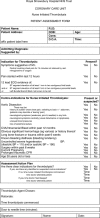Improving door to needle times with nurse initiated thrombolysis
- PMID: 10956286
- PMCID: PMC1760948
- DOI: 10.1136/heart.84.3.262
Improving door to needle times with nurse initiated thrombolysis
Abstract
Objective: To evaluate the effect of nurse initiated thrombolysis on door to needle time (the interval between arriving at the hospital and starting thrombolytic treatment) in patients with acute myocardial infarction.
Design: Comparison of door to needle times before and after the employment of nurses trained and approved to initiate thrombolysis without prescription by a doctor but with a protocol for rapid triage of patients with chest pain.
Setting: A district general hospital.
Subjects: All patients admitted with suspected myocardial infarction between April 1995 and March 1999.
Main outcome measures: Speed (door to needle time) and appropriateness of administration of thrombolytic drugs to patients with acute myocardial infarction who gave a characteristic history and had appropriate criteria on the admission ECG.
Results: During seven periods (each of four months) before the introduction of nurse initiated thrombolysis and a new chest pain triage protocol, the median door to needle time varied from 50-58 minutes. In four periods (each of 4-6 months) following the introduction of the changes, the median door to needle time was 25-30 minutes. The improvement was significant (p < 0.001). Nurses trained to initiate thrombolysis currently provide cover for 66% of the time. Median door to needle time for nurses was 15 minutes. Median door to needle time for junior doctors improved to 35 minutes. The median door to needle times when nurses initiated thrombolysis was significantly shorter than when doctors did so (p < 0.001). There have been no inappropriate management decisions by nurses approved to initiate thrombolysis.
Conclusions: The use of nurse initiated thrombolysis has resulted in a clinically important reduction in the time taken for thrombolysis to be started in patients with acute myocardial infarction.
Figures



Similar articles
-
Safety and efficacy of nurse initiated thrombolysis in patients with acute myocardial infarction.BMJ. 2002 Jun 1;324(7349):1328-31. doi: 10.1136/bmj.324.7349.1328. BMJ. 2002. PMID: 12039831 Free PMC article.
-
Effectiveness of a 'thrombolysis nurse' in shortening delay to thrombolysis in acute myocardial infarction.J R Coll Physicians Lond. 1999 Jan-Feb;33(1):46-50. J R Coll Physicians Lond. 1999. PMID: 10192070 Free PMC article.
-
An audit of clinical nurse practitioner led thrombolysis to improve the treatment of acute myocardial infarction.J Public Health Med. 2000 Dec;22(4):462-5. doi: 10.1093/pubmed/22.4.462. J Public Health Med. 2000. PMID: 11192272
-
Managing thrombolysis in the accident and emergency department.Accid Emerg Nurs. 2003 Jan;11(1):33-8. doi: 10.1016/s0965-2302(02)00164-9. Accid Emerg Nurs. 2003. PMID: 12718949 Review.
-
Door to needle times bulls' eye or just bull? The effect of reducing door to needle times on the appropriate administration of thrombolysis: implications and recommendations.Eur J Cardiovasc Nurs. 2003 Apr;2(1):39-45. doi: 10.1016/S1474-5151(03)00005-7. Eur J Cardiovasc Nurs. 2003. PMID: 14622647 Review.
Cited by
-
Nursing role to improve care to infarct patients and patients undergoing heart surgery: 10 years' experience.Neth Heart J. 2012 Jan;20(1):5-11. doi: 10.1007/s12471-011-0225-y. Neth Heart J. 2012. PMID: 22194095 Free PMC article.
-
Stroke code simulation benefits advanced practice providers similar to neurology residents.Neurol Clin Pract. 2018 Apr;8(2):116-119. doi: 10.1212/CPJ.0000000000000435. Neurol Clin Pract. 2018. PMID: 29708218 Free PMC article.
-
Emergency department thrombolysis improves door to needle times.Emerg Med J. 2004 Nov;21(6):676-80. doi: 10.1136/emj.2004.014449. Emerg Med J. 2004. PMID: 15496692 Free PMC article.
-
Reduction in Door-to-Needle Time after Transfer of Thrombolysis Site from CCU to Emergency Department.Emerg Med Int. 2013;2013:208271. doi: 10.1155/2013/208271. Epub 2013 Sep 24. Emerg Med Int. 2013. PMID: 24205437 Free PMC article.
-
Using simulation to estimate the cost effectiveness of improving ambulance and thrombolysis response times after myocardial infarction.Emerg Med J. 2006 Jan;23(1):67-72. doi: 10.1136/emj.2004.023036. Emerg Med J. 2006. PMID: 16381082 Free PMC article.
References
MeSH terms
LinkOut - more resources
Full Text Sources
Medical
Miscellaneous
